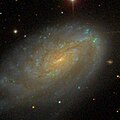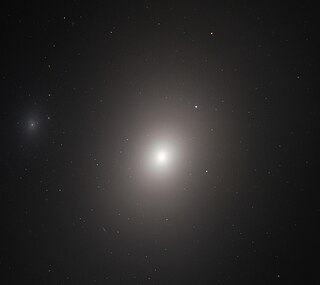
Messier 86 is an elliptical or lenticular galaxy in the constellation Virgo. It was discovered by Charles Messier in 1781. M86 lies in the heart of the Virgo Cluster of galaxies and forms a most conspicuous group with another large galaxy known as Messier 84. It displays the highest blue shift of all Messier objects, as it is, net of its other vectors of travel, approaching the Milky Way at 244 km/s. This is due to both galaxies falling roughly towards the center of the Virgo cluster from opposing ends.

Messier 90 is an intermediate spiral galaxy exhibiting a weak inner ring structure about 60 million light-years away in the constellation Virgo. It was discovered by Charles Messier in 1781.
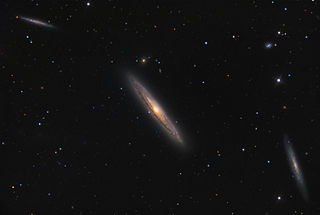
NGC 4216 is a metal-rich intermediate spiral galaxy located not far from the center of the Virgo Cluster of galaxies, roughly 55 million light-years away. It is seen nearly edge-on.

The Eyes Galaxies are a pair of galaxies about 52 million light-years away in the constellation Virgo. The pair are members of the string of galaxies known as Markarian's Chain.
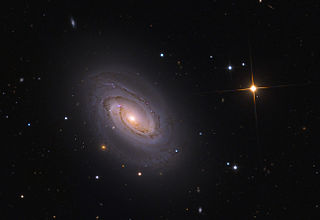
NGC 4450 is a spiral galaxy in the constellation Coma Berenices.

NGC 4639 is a barred spiral galaxy located in the equatorial constellation of Virgo. It was discovered by German-born astronomer William Herschel on April 12, 1784. John L. E. Dreyer described it as "pretty bright, small, extended, mottled but not resolved, 12th magnitude star 1 arcmin to southeast". This is a relatively nearby galaxy, lying approximately 72 million light-years away from the Milky Way. It is a companion to NGC 4654, and the two appear to have interacted roughly 500 million years ago. NGC 4639 is a member of the Virgo Cluster.

An anemic galaxy is a type of spiral galaxy characterized by a low contrast between its spiral arms and its disk.

NGC 4651 is a spiral galaxy located in the constellation of Coma Berenices that can be seen with amateur telescopes, at a distance not well determined that ranges from 35 million light years to 72 million light years.

NGC 4262 is a lenticular galaxy located in the constellation of Coma Berenices.
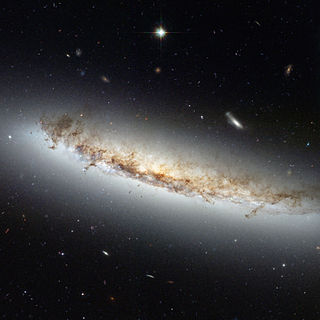
NGC 4402 is a relatively near, edge-on spiral galaxy located around 50 million light-years from Earth. It is in the constellation of Virgo within the Virgo Cluster of galaxies. It can be seen when viewing Markarian's Chain.
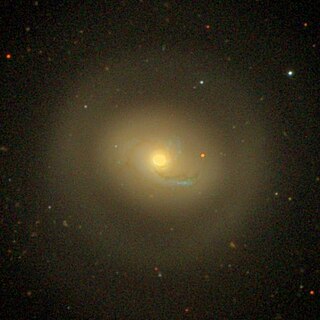
NGC 4457 is an intermediate spiral galaxy located about 55 million light-years away in the constellation of Virgo. It is also classified as a LINER galaxy, a class of active galaxy defined by their spectral line emissions. NGC 4457 Is inclined by about 33°. It was discovered by astronomer William Herschel on February 23, 1784. Despite being listed in the Virgo Cluster Catalog as VCC 1145, NGC 4457 is a member of the Virgo II Groups which form an extension of the Virgo cluster.

NGC 4606 is a spiral galaxy located about 55 million light-years away in the constellation of Virgo. NGC 4606 was discovered by astronomer William Herschel on March 15, 1784. It has a disturbed stellar disk suggesting the actions of gravitational interactions. NGC 4607 may be a possible companion of NGC 4606. However, their redshifts differ by about 600 km/s, making it unlikely that they are a gravitationally bound pair. NGC 4606 is a member of the Virgo Cluster.

NGC 4476 is a lenticular galaxy located about 55 million light-years away in the constellation Virgo. NGC 4476 was discovered by astronomer William Herschel on April 12, 1784. The galaxy is a member of the Virgo Cluster.

NGC 4522 is an edge-on spiral galaxy located about 60 million light-years away within the Virgo Cluster in the constellation Virgo. NGC 4522 is losing its molecular gas though ram-pressure stripping as it plows though the cluster at a speed of more than 10 million kilometres per hour. The galaxy was discovered by astronomer John Herschel on January 18, 1828.

NGC 4580 is an unbarred spiral galaxy located about 70 million light-years away in the constellation Virgo. NGC 4580 is also classified as a LINER galaxy. It was discovered by astronomer William Herschel on February 2, 1786 and is a member of the Virgo Cluster.

NGC 4607 is an edge-on spiral galaxy located about 56 million light-years away in the constellation Virgo. NGC 4607 was discovered by astronomer R. J. Mitchell on April 24, 1854. The galaxy is a member of the Virgo Cluster.

NGC 4294 is a barred spiral galaxy with flocculent spiral arms located about 55 million light-years away in the constellation Virgo. The galaxy was discovered by astronomer William Herschel on March 15, 1784 and is a member of the Virgo Cluster.

NGC 4298 is a flocculent spiral galaxy located about 53 million light-years away in the constellation Coma Berenices. The galaxy was discovered by astronomer William Herschel on April 8, 1784 and is a member of the Virgo Cluster.

NGC 4299 is a featureless spiral galaxy located about 55 million light-years away in the constellation Virgo. It was discovered by astronomer William Herschel on March 15, 1784 and is a member of the Virgo Cluster.

NGC 4302 is an edge-on spiral galaxy located about 55 million light-years away in the constellation Coma Berenices. It was discovered by astronomer William Herschel on April 8, 1784 and is a member of the Virgo Cluster.

